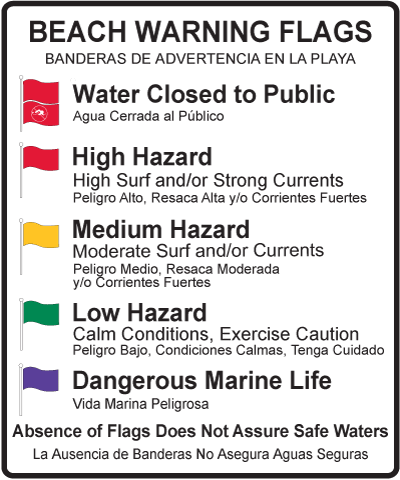How to Know if it's Safe to Swim at the Beach
When you’re at the beach, it can be hard to know whether or not it’s safe to swim in the water. While some of us might already know the basics, there are plenty of newcomers to swimming at the beach who could use some guidance on what to look out for so they can enjoy their day at the beach while staying safe and sound.
What is the Beach Flag System?
While we'd all like to believe that swimming at a beach is perfectly safe, unfortunately, that isn't always true. The Beach Flag System was created by government and non-profit organizations in an effort to make us more aware of water conditions during our beach visits. At its most basic level, there are five different flags, each with its own meaning: red flags indicate not only poor conditions but also imminent danger; yellow flags mean caution due to a strong current or rough waves; green flags mean excellent conditions; purple flags mean there are marine pests in the water like jellyfish, stingrays & dangerous fish. One of our best tips for staying safe on the beach is keeping an eye on which flag is flying when you visit.
Red Flag conditions on the beach
This means dangerous rip currents and/or hazardous waves. If you’re planning on going into any bodies of water, stay far away from red flag conditions! Always check with your local beach officials for flag conditions before you go in; red flags indicate when it is unsafe to enter water or even hang out near water. You should never enter water that has a Red Flag unless you are with an experienced lifeguard who knows how to get people out of trouble safely. Even experienced swimmers can be pulled into dangerous waters by riptides, so use caution! Stay clear of red flags unless you are 100% sure about what’s going on around you.
Yellow Flags
One yellow flag, displayed with either red or black flags, indicates that dangerous swimming conditions exist. Surfing, boogie boarding and other non-motorized water sports are not permitted. If there is more than one yellow flag flying, surfing is permitted but body contact is prohibited. If a red flag is flying with a yellow flag, swimming is prohibited because of serious water dangers; however, motorized watercraft may be used in designated areas during daylight hours.
Green Flags
The green flag means that conditions are safe and there are no strong currents, riptides, or undertows. It also indicates that there are lifeguards on duty and nearby. At a beach with a green flag, it’s safe for children to swim and learn how to swim. The water is calm enough for swimming.
Purple Flag for Marine Pests
Avoiding harmful marine pests is an important part of beach safety, especially in areas where they’re common. The purple flag indicates that high populations of marine pests have been spotted in an area and that those who are in or near water should avoid direct contact with potentially affected areas.
Double Red Flag Conditions
When two red flags are flying, no swimming is allowed. No matter how good of a swimmer you are, if there’s lightning and choppy waves, you should stay out of the water. Double red flag conditions mean hazardous swimming conditions due to dangerous marine life like jellyfish and stinging coral. Unless your name is Tom Hanks and you have a volleyball named Wilson with an unshakable faith in your survival skills—wait on shore until conditions improve.
Rip Current
A rip current is a narrow channel of water flowing away from shore, often taking swimmers with it. Rip currents can pull swimmers far offshore and out to sea very quickly. If you’re caught in a rip current, don’t fight against it. Instead, swim parallel to shore until you are out of its pull. Then head for land and safety. A lifeguard can help rescue anyone who gets caught in a rip current; look for one on duty when you arrive at any beach area.


